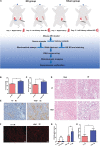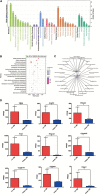Transcriptomic Analysis Revealed an Important Role of Peroxisome-Proliferator-Activated Receptor Alpha Signaling in Src Homology Region 2 Domain-Containing Phosphatase-1 Insufficiency Leading to the Development of Renal Ischemia-Reperfusion Injury
- PMID: 35646989
- PMCID: PMC9134314
- DOI: 10.3389/fmed.2022.847512
Transcriptomic Analysis Revealed an Important Role of Peroxisome-Proliferator-Activated Receptor Alpha Signaling in Src Homology Region 2 Domain-Containing Phosphatase-1 Insufficiency Leading to the Development of Renal Ischemia-Reperfusion Injury
Abstract
In kidney transplantation, the donor kidney inevitably undergoes ischemia-reperfusion injury (IRI). It is of great importance to study the pathogenesis of IRI and find effective measures to attenuate acute injury of renal tubules after ischemia-reperfusion. Our previous study found that Src homology region 2 domain-containing phosphatase-1 (SHP-1) insufficiency aggravates renal IRI. In this study, we systematically analyzed differences in the expression profiles of SHP-1 (encoded by Ptpn6)-insufficient mice and wild-type mice by RNA-seq. We found that a total of 161 genes showed at least a twofold change, with a false discovery rate <0.05 in Ptpn6 +/mev mice after IRI and 42 genes showing more than a fourfold change. Of the eight genes encoding proteins with immunoreceptor tyrosine-based inhibitory motifs (ITIMs) that bind to Ptpn6, three were upregulated, and five were downregulated. We found that for the differentially expressed genes (DEGs) with a fold change >2, the most significantly enriched Kyoto Encyclopedia of Genes and Genomes (KEGG) pathways were the cell division pathway and peroxisome-proliferator activated receptor PPARα signaling pathways. Furthermore, the downregulated genes of the PPARα signaling pathway were mainly related to fatty acid absorption and degradation. Using an agonist of the PPARα signaling pathway, fenofibrate, we found that renal IRI was significantly attenuated in Ptpn6 +/mev mice. In summary, our results show that insufficiency of SHP-1 inhibits the expression of genes in the PPARα signaling pathway, thereby leading to increased reactive oxygen species (ROS) and exacerbating the renal IRI. The PPARα signaling agonist fenofibrate partially attenuates renal IRI induced by SHP-1 insufficiency.
Keywords: PPARα signaling; SHP-1; bioinformatics; kidney transplantation; renal ischemia-reperfusion injury.
Copyright © 2022 Yan, Sui, Tian, Fu, Li, Chen, Zeng and Ding.
Conflict of interest statement
The authors declare that the research was conducted in the absence of any commercial or financial relationships that could be construed as a potential conflict of interest.
Figures





Similar articles
-
Protective effect of Fenofibrate in renal ischemia reperfusion injury: Involved in suppressing kinase 2 (JAK2)/transcription 3 (STAT3)/p53 signaling activation.Pathol Biol (Paris). 2015 Dec;63(6):236-42. doi: 10.1016/j.patbio.2015.07.010. Epub 2015 Sep 2. Pathol Biol (Paris). 2015. PMID: 26343046
-
Elucidating the molecular pathways and immune system transcriptome during ischemia-reperfusion injury in renal transplantation.Int Immunopharmacol. 2020 Apr;81:106246. doi: 10.1016/j.intimp.2020.106246. Epub 2020 Feb 7. Int Immunopharmacol. 2020. PMID: 32044658
-
Lentivirus-Mediated Silencing of Src Homology 2 Domain-Containing Protein Tyrosine Phosphatase 2 Inhibits Release of Inflammatory Cytokines and Apoptosis in Renal Tubular Epithelial Cells Via Inhibition of the TLR4/NF-kB Pathway in Renal Ischemia-Reperfusion Injury.Kidney Blood Press Res. 2018;43(4):1084-1103. doi: 10.1159/000491565. Epub 2018 Jul 10. Kidney Blood Press Res. 2018. Retraction in: Kidney Blood Press Res. 2021;46(5):657. doi: 10.1159/000519996. PMID: 29991025 Retracted.
-
Identification of biomarkers, immune infiltration landscape, and treatment targets of ischemia-reperfusion acute kidney injury at an early stage by bioinformatics methods.Hereditas. 2022 Jun 4;159(1):24. doi: 10.1186/s41065-022-00236-x. Hereditas. 2022. PMID: 35658960 Free PMC article.
-
Fenofibrate pre-treatment suppressed inflammation by activating phosphoinositide 3 kinase/protein kinase B (PI3K/Akt) signaling in renal ischemia-reperfusion injury.J Huazhong Univ Sci Technolog Med Sci. 2015 Feb;35(1):58-63. doi: 10.1007/s11596-015-1389-2. Epub 2015 Feb 12. J Huazhong Univ Sci Technolog Med Sci. 2015. PMID: 25673194
References
-
- Blanchette J, Racette N, Faure R, Siminovitch KA, Olivier M. Leishmania-induced increases in activation of macrophage SHP-1 tyrosine phosphatase are associated with impaired IFN-γ-triggered JAK2 activation. Eur J Immunol. (1999) 29:3737–44. 10.1002/(SICI)1521-4141(199911)29:113.0.CO;2-S - DOI - PubMed
LinkOut - more resources
Full Text Sources
Molecular Biology Databases
Miscellaneous

